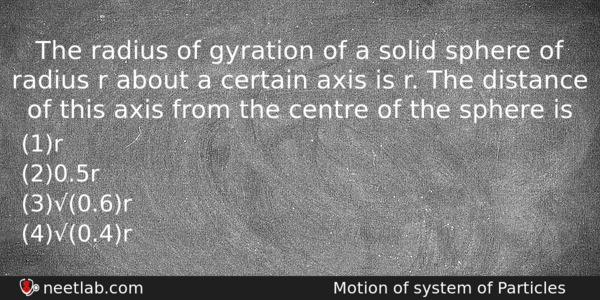| ⇦ | 
| ⇨ |
The radius of gyration of a solid sphere of radius r about a certain axis is r. The distance of this axis from the centre of the sphere is
Options
(a) r
(b) 0.5r
(c) √(0.6)r
(d) √(0.4)r
Correct Answer:
√(0.6)r
Explanation:
No explanation available. Be the first to write the explanation for this question by commenting below.
Related Questions: - A person of mass 60 kg is inside a lift of mass 940 kg and presses the button on control panel.The lift starts moving upwards wi
- An object is seen through a simple microscope of focal length 12 cm.
- A generator at a utility company produces 100 A of current at 4000 V. The voltage
- In Young’s double silt experiment if the distance between the two slits
- A ballet dancer, dancing on smooth floor, is spinning about a vertical axis
Topics: Motion of system of Particles and Rigid Body
(73)
Subject: Physics
(2479)
Important MCQs Based on Medical Entrance Examinations To Improve Your NEET Score
- A person of mass 60 kg is inside a lift of mass 940 kg and presses the button on control panel.The lift starts moving upwards wi
- An object is seen through a simple microscope of focal length 12 cm.
- A generator at a utility company produces 100 A of current at 4000 V. The voltage
- In Young’s double silt experiment if the distance between the two slits
- A ballet dancer, dancing on smooth floor, is spinning about a vertical axis
Topics: Motion of system of Particles and Rigid Body (73)
Subject: Physics (2479)
Important MCQs Based on Medical Entrance Examinations To Improve Your NEET Score
18000+ students are using NEETLab to improve their score. What about you?
Solve Previous Year MCQs, Mock Tests, Topicwise Practice Tests, Identify Weak Topics, Formula Flash cards and much more is available in NEETLab Android App to improve your NEET score.
Share this page with your friends

Using parallel axis theorem ,
I =Icm(about the centre of mass) + M(mass of the sphere)h2. where h is the required distance of the axis from centre of sphere
MK2 = 2/5 MR2. + Mh2
K2= 2R2/5 + h2
R2 = 2R2/5. + h2. (given that. K=R. )
3R2/5 = h2
Which gives h=√3/5R2
h=√0.6. R. (Answer)